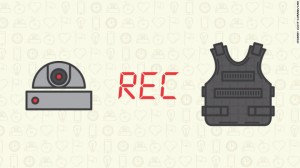Williams C., Lauren. “Why Cameras Alone Won’t Solve Our Police Abuse Problem.” Thinkprogress.org. ThinkProgress, 19 Aug. 2014. Web. 11 Aug. 2015.
Lauren C. Williams’s article “Why Cameras Alone Won’t Solve Our Police Abuse Problem” discusses the possibility that videos from police cameras can be subjected to abuse if not carefully mitigated during police reform just like other law enforcement tools. This idea comes from the statements of Hanni Fakuory, an attorney with the Electronic Frontier Foundation in San Francisco. Fakuory also states that the “use of video footage of police misconduct doesn’t always yield justice.”
Within the article Fakuory provides two reasons behind her claim of police body cameras subjecting abuse. Her first reason states that Justice is not guaranteed. She begins stating that “witnesses’ and police video recordings, even those that may be damming, have not consistently led to convictions in the past of police accused of violating citizens’ rights.” She then offers a couple of examples, one pertaining to a Chicago police officer who was not charged despite video footage showing him standing over a victim’s body fatally shooting the unarmed man on in 2013. Another example she offers is an incident that happened earlier this year. Police officers caught on tape beating a schizophrenic homeless man to death were acquitted by a jury. As videos go viral of police abuse, little legal action has been sparked. As Fakuory’s final example, she brings up the Eric Garner case stating that no charges have been brought against the officers involved in his death even after the medical examiner ruled the killing a homicide. Instead, the officer who fired the deadly shot was found guilty of involuntary manslaughter instead of murder.
As some police departments have adopted body cameras, Fakuory suggest that others have rejected the technology after learning that Los Angeles police officers were caught disabling voice recording equipment on about 50 squad cars, most of which were used to patrol low-income communities densely populated with people of color. And in cases where cameras are used, departments frequently deny request for footage or tamper footage before its release.
Fakuory’s second reason supporting her claim surrounds the potential for abuse. She states “when it comes to technology, there’s the potential for abuse.” Overall law enforcement’s history with technology tends to follow the same pattern: “when they get new tools, they use them aggressively especially as these things get smaller and easier to use.” She begins to compare body cameras to what happened when police forces began using tasers and mace. Although these methods were introduced as a non-lethal way to subdue suspects, they have become prone to abuse. Fakuory closes with evidence within the New York Police Department that support her claim of lethal force.
Although I do agree with Fakuory’s reasoning in that even if video footage is provided, officers in some cases do in fact do not get charged with their actions towards civilians. In a sense, just because we capture events on camera it does not mean justice will be served as much as we would like to see it be. However, I completely disagree with her comparison of video cameras to other tools such as tasers and mace. This comparison is outrageous and should not be believed by the audience due to it being a clearly false analogy. This analogy compares two things that share no similarity, and in this case body cameras have nothing to do with mace and tasers. Fakuory wants the audience to believe that these cameras could become a lethal force, which is ridiculous to think about. Would such a camera become a blunt weapon of some sort? Ultimately resulting in her uncanny argument.


